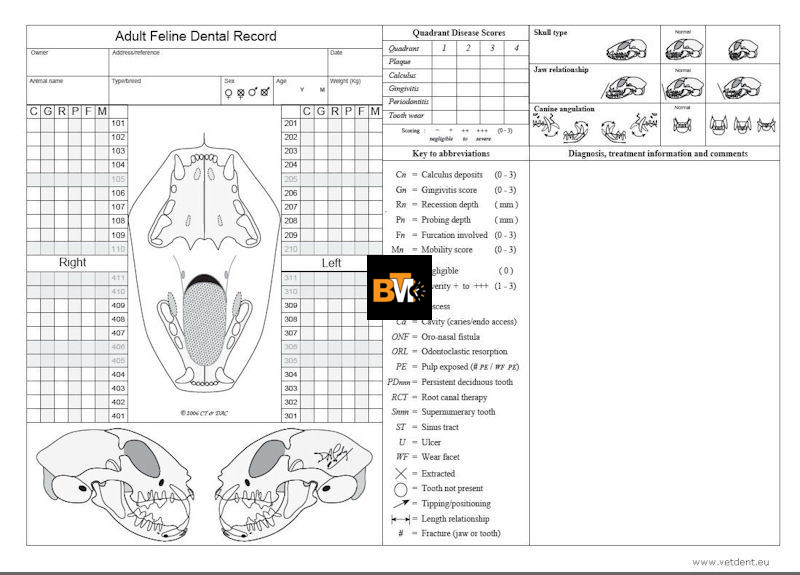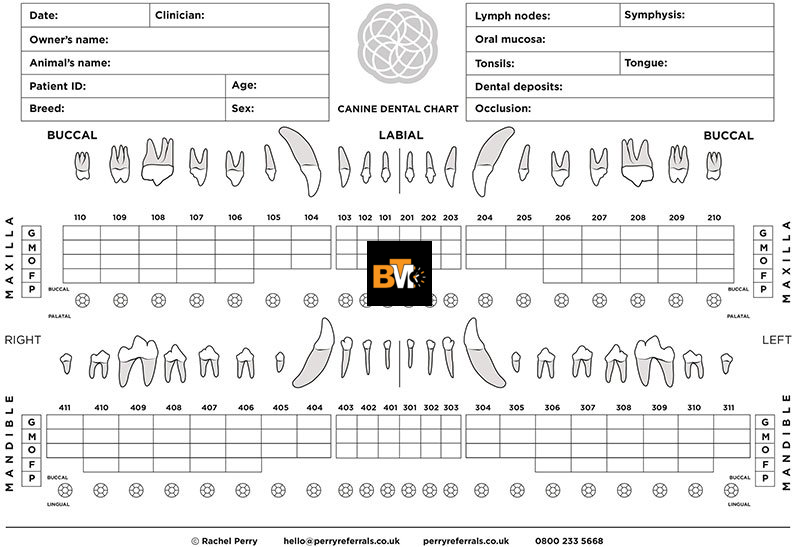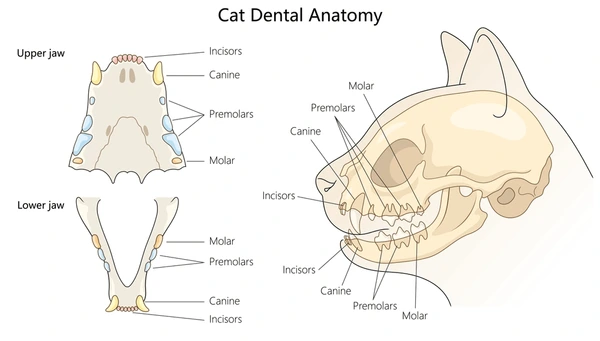Taking care of your cat’s teeth is just as important as feeding them the right food or giving them love and attention. A feline dental chart helps you and your vet understand what’s going on inside your cat’s mouth. From tiny kitten teeth to strong adult fangs, this guide will help you learn everything you need to keep your cat’s smile healthy.
What Is a Feline Dental Chart?
A feline dental chart is a visual guide that shows all the teeth in a cat’s mouth, where each one is located, and what it’s used for. Vets use this chart to record the condition of each tooth—marking any issues like cavities, tartar, missing teeth, or gum disease. Think of it like a report card for your cat’s dental health.
Every tooth in the chart is given a specific number or letter depending on its location (left, right, upper, lower) and type (incisor, canine, premolar, molar). This makes it easy to track dental problems over time and know exactly which teeth need treatment. Whether you’re a cat parent or a vet tech in training, understanding the feline dental chart helps you spot issues before they get worse.
Why Cats Need Strong Teeth
Cats use their teeth for more than just chewing food. Their teeth are essential for biting, hunting (even if your cat is just chasing toys), grooming, and defending themselves if needed. Healthy teeth help your cat eat comfortably and stay active.
When a cat has dental problems, it can lead to serious health issues—not just in the mouth, but also in other parts of the body. Bacteria from infected gums can spread through the bloodstream and affect organs like the heart and kidneys. That’s why taking care of your cat’s teeth isn’t just about fresh breath—it’s about their whole health.
How Many Teeth Do Cats Have?
Cats have two sets of teeth in their lifetime: baby (deciduous) teeth and adult (permanent) teeth. Just like humans, kittens start with small baby teeth and later lose them to grow a full set of adult teeth.

Baby Teeth Timeline
Kittens are born without teeth. Around 2 to 3 weeks of age, their baby teeth start coming in. By 6 weeks, most kittens have all 26 of their deciduous teeth. These small, sharp teeth are temporary, and they start falling out between 3 to 4 months of age as adult teeth come in.
Here’s a quick timeline:
- 2-3 weeks: Incisors appear
- 3-4 weeks: Canines come in
- 4-6 weeks: Premolars develop
- 6 weeks: Full set of 26 baby teeth
Adult Teeth Timeline
By the time a cat is 6 to 7 months old, they should have all 30 of their permanent teeth. These adult teeth are stronger, longer, and made to last a lifetime (with proper care).
Timeline for adult teeth:
- 3-4 months: Incisors erupt
- 4-5 months: Canines and premolars come in
- 5-6 months: Molars finish erupting
Tooth Types and Jobs
Cats have four types of teeth, each with a special role:
- Incisors (12 total): These are the small teeth in the front. They help with grooming and nibbling.
- Canines (4 total): Long and sharp, these teeth are perfect for gripping prey or tearing meat.
- Premolars (10 total): Located behind the canines, they help slice food into smaller pieces.
- Molars (4 total): Found in the back of the mouth, these teeth grind food—especially dry kibble.
Understanding the job of each tooth helps you know what to watch for. If your cat’s canines are broken or their molars are worn down, they may have trouble eating or be in pain.
What a Vet Sees in a Dental Chart
When your cat goes to the vet for a dental checkup, the vet uses the feline dental chart to record every tooth’s condition. This includes whether a tooth is healthy, cracked, missing, loose, or covered in plaque or tartar. They also note gum health—checking for redness, swelling, or pockets around the teeth (a sign of gum disease).
The chart is used to:
- Document missing or extracted teeth
- Track dental disease progression
- Record treatment plans
- Monitor post-surgery recovery
Veterinarians also use dental X-rays alongside the chart to see problems below the gum line. All this data helps your vet make the best decision for your cat’s health, whether that means cleaning, extraction, or just monitoring.
Signs Your Cat Has Tooth Trouble
Cats are experts at hiding pain, so dental problems can go unnoticed. But if you know what to look for, you can catch issues early and avoid more serious problems.
Here are common signs of dental trouble:
- Bad breath (not just after eating fish!)
- Drooling or dropping food
- Swollen face or jaw
- Pawing at the mouth
- Bleeding gums or blood on toys
- Weight loss or refusal to eat
- Chattering teeth or strange mouth movements
If your cat shows any of these symptoms, it’s time for a dental checkup. Delaying treatment can lead to infections, abscesses, and even tooth loss.
Cleaning Your Cat’s Teeth at Home
Brushing your cat’s teeth might sound tricky, but it’s one of the best ways to prevent dental disease. With patience and the right tools, you can make it a normal part of your cat’s routine.

Tools You’ll Need
To clean your cat’s teeth safely, you’ll need:
- Pet toothbrush: Small, soft-bristled brushes made for cats
- Cat toothpaste: Enzymatic toothpaste in flavors like chicken or fish (never use human toothpaste!)
- Dental wipes: Good for quick cleanings when brushing isn’t possible
- Dental treats and chews: Help reduce plaque buildup
- Water additives: Mixed into drinking water to freshen breath and reduce bacteria
Optional but helpful:
- Finger brush: A rubber brush that fits on your finger for better control
- Cat dental toys: Encourage chewing and naturally clean teeth
How Often to Brush
Ideally, you should brush your cat’s teeth daily. If that’s not realistic, aim for at least three times a week. The more often you brush, the better the results.
Start slowly:
- Let your cat sniff and taste the toothpaste.
- Gently touch their mouth and lift the lips.
- Try brushing one or two teeth at a time.
- Give treats and praise afterward.
Consistency is key. The more you practice, the easier it gets—for both you and your cat.
When to Visit the Vet for Teeth
Even with regular home care, your cat should visit the vet for a dental exam at least once a year. Some cats—especially older ones or those with known dental issues—may need checkups every 6 months.
Professional cleanings are done under anesthesia and include:
- Scaling tartar from teeth
- Polishing tooth surfaces
- Cleaning under the gums
- Dental X-rays
- Tooth extraction (if needed)
Regular vet visits catch problems early and keep your cat’s mouth in top shape.
Fun Facts About Cat Teeth
Here are some fun and surprising facts about your cat’s teeth:
- Cats are obligate carnivores, and their teeth are designed for tearing, not chewing like ours.
- A cat’s canine teeth can be over half an inch long—perfect for catching prey.
- Unlike humans, cats don’t get cavities often, but they are prone to resorptive lesions, where the tooth breaks down from the inside.
- Kittens lose their baby teeth just like human kids, usually swallowing them in the process.
- Ancient wildcats had similar dental structures to today’s house cats, showing how little they’ve changed over time.
The Bottom Line
Your cat’s teeth play a huge role in their overall health and happiness. With the help of a feline dental chart, you and your vet can understand what’s happening inside your cat’s mouth and spot problems early. From learning how many teeth cats have to knowing the signs of dental disease and how to brush their teeth at home, it’s all part of being a responsible and loving cat parent.
Start small: check your cat’s mouth once a week, use treats and praise to make brushing easier, and don’t skip those annual vet visits. With a little effort, your cat’s smile can stay healthy for years to come.







Leave a Reply